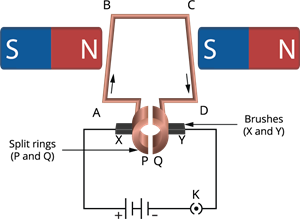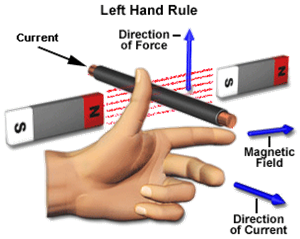PDF chapter test TRY NOW
In this section, we shall discuss the electric motor, which follows the principle that the current-carrying conductor produces a magnetic field around it.
Electric motor:
Electric motor:
An electric motor is a type of rotating device. It converts electrical energy to mechanical energy. The electric motor is used as an essential component in electric fans, refrigerators, mixers, washing machines, computers, MP3 players, etc.,
Construction:
As shown in the below figure, an electric motor has a rectangular coil ABCD of insulated copper wire. The coil is located between the two poles of a magnetic field such that the arm AB and CD are perpendicular to the direction of the magnetic field. The ends of the coil (ABCD) are attached to the two halves, P and Q, of a split ring. The inner sides of these split ring halves are insulated and connected to an axle. The external conducting edges of the split ring, P and Q, are in contact with two conducting stationary brushes X and Y, respectively (as shown in the figure).

A simple electric motor
How does an electric motor works?
Current in the coil, ABCD starts to flow from the source battery through conducting brush X and return to the battery through brush Y. Notice that the current in arm AB of the coil flows from A to B. In arm CD, the current flows from C to D. The current flows through the arm CD opposite to the current direction through the arm AB.
Fleming’s left-hand rule is applied here to find the direction of the force on a current-carrying conductor in a magnetic field (see the below figure).

Fleming’s left-hand rule
We can observe that the force acting on arm AB drives it downwards while the force acting on arm CD drives it upwards. Thus, the coil and the axle O are positioned free to turn about an axis, rotate anti-clockwise. At half rotation, Q is in contact with the brush X and P with brush Y. Hence, the current in the coil gets reversed and flows along the path DCBA.
The commutator is a device that reverses the direction of the flow of current through a circuit. In electric motors, the split ring works as a commutator. The reversal of current in a circuit also reverses the direction of force acting on the arms AB and CD. Therefore, the arm AB of the coil that was previously pushed down is now pushed up, and the arm CD earlier pushed up is now pushed down. So the coil and the axle rotate half a turn more in the same direction. The reversing of the current is done at each half rotation, providing rise to a continuous rotation of the coil and the axle.
The commercial motors use:
- An electromagnet replaces the permanent magnet.
- A conducting wire with a large number of turns in the current-carrying coil.
- A soft iron core on which the coil is wound.
The soft iron core, on which the coil is wound, plus the coils, is called an armature. This improves the power of the motor.
Reference:
https://commons.wikimedia.org/wiki/File:Fleming-left-hand-rule.png
